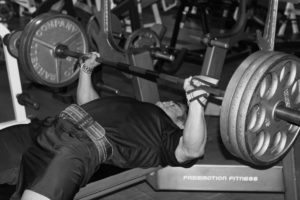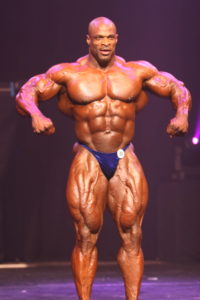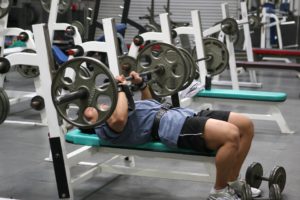
What serious athletes need to know about training this powerful lift
By Strength Sensei CP
Publication Date: 1996
It doesn’t matter if it’s not the best upper body exercise. It doesn’t matter if it may cause pec tears and shoulder injuries. A big bench press – no, an awesome bench press – that’s what really matters. Helping you get one is what this article is about. But before reading further, understand that I wrote this article for experience male athletes — athletes who bench press one-and-a-half times their bodyweight and hunger for at least double bodyweight within one year. If you’re a beginner, have your mother, spouse, or girlfriend hold onto this article until you’ve paid your dues.
Having sent the kiddies to bed, let’s get on with a serious discussion for the serious bencher. We’re going to look at six important steps to improving this lift, steps that are probably overlooked and definitely misunderstood. Separately, each of these suggestions will positively influence your training; together, they will produce a Gestalt effect that will unleash your physical potential.
Step 1: Determine your Primary Weakness
The first step to improving your bench press is to determine where you’re having the most trouble. Where do you fail? At the start? Mid-range? Lockout? The most practical way to determine your weakness is to perform a maximum single attempt. (Because strength curves change with fatigue, you must perform a maximum single; doing reps to failure and using conversion charts won’t give you an accurate assessment.) As you perform your max, observe where you reach a sticking point; have a training partner watch, too. Then study Table 1 to determine which muscle group(s) you need to strengthen according to your pressing style.
| Pressing Style | Sticking Point | Target Muscle |
| Close Grip
Wide Grip |
Start
Mid-Range |
Serratus Anterior
|
| Both | Start | Anterior Deltoid |
| Wide Grip | Start | Pectoralis Major – Clavicular Subscapularis |
| Close Grip | Start | Pectoralis Major
(Sternal Portion) |
| Wide Grip | Mid-Range | Biceps (long head) and Coracobrachialis |
| Both | Lockout | Triceps |
Table 1: Target Muscle Groups in the Bench Press and Function (All Rights Reserved, Poliquin 1995 ©)

Eight-time Mr. Olympia Ronnie Coleman possessed full, thick pectoral muscles that enabled him to perform 12 reps in the dumbbell bench press with 200 pounds in each hand, and bench press 495 for five reps. All bodybuilding photos by Milos Sarcev.
Step 2: Select the Appropriate Assistance Exercises
Many a Joe Average bencher has stayed average by doing too many worthless assistance exercises. Even though there are countless assistance exercises, few will improve bench press performance. Sure, triceps pressdowns and kickbacks may bulk up your arm from 18 to 18.25 inches, but these exercises do not recruit enough motor units for the experienced lifter. If you need more triceps work, exercises more closely resembling the mechanics of the bench press will have a greater transfer effect.
Table 2 lists the assistance exercises of choice for attacking your sticking points.
| Target Muscle | Assistance Exercises |
| Serratus Anterior | Incline Front Raises
Front Cable Raises |
| Biceps (long head) | Barbell Curls
Incline Curls Standing Cable Curls (Note: Any type of curl where the upper arm is in line with the torso or behind it.)
|
| Anterior Deltoid | Seated Press Behind the Neck
Seated Dumbbell Press, Semi-Supinated Seated Military Press |
| Pectorals Major
(Clavicular Portion) |
Wide-Grip Bench Press to Collarbone
Bent-Arm Flyes Flat Crossovers Partial Bench Press (first half) Functional Isometrics Incline Press Flat Dumbbell Press, Pronated |
| Pectorals Major
(Sternal Portion) |
Parallel Bar Dips
Decline Press Decline Flyes (dumbbell and cables) Functional Isometrics Flat Dumbbell Press, Semi-Supinated) |
| Triceps | Triceps Extension to the Neck
Parallel Bar Dips Nose Crunchers Lockouts in Power Rack Close-Grip Bench Press Reverse-Grip Bench Press |
Table 2: Assistance Exercises for the Bench Press. (All Rights Reserved, Poliquin 1991 ©)

The best assistance exercises for the bench press closely resemble the mechanics of the bench press. Milos Sarcev photo.
Step 3: Use the Appropriate Exercise Order
Health for Life calls it synergy! Weider calls it priority training! Exercise scientists call it the principle of specificity! Whatever it’s called, the order in which you perform exercises will have a specific effect on your training results. As a general rule, use the following order for bench pressing and assistance exercises:
- Bench press exercise
- Serratus anterior or one anterior deltoid exercise
- 1 or 2 triceps exercises
- 1 or 2 biceps exercises
Step 4: Strengthen and Stretch the Rotator Cuff Muscles
The most common setback in bench press training is imbalanced development between the synergists and the prime movers. Weak or injured rotator cuff muscles retard both strength and growth. Before pursuing a serious bench press specialization program, spend at least four weeks strengthening and stretching the rotator cuff muscles. Not only will these exercises prevent injury, they will also improve your lifting mechanics by enabling you to adopt the most effective bar pathway. (Note: A description of all the strengthening and stretching exercises for the rotator cuff is beyond the scope of this article; consult a sports-oriented chiropractor or physiotherapist for advice.)

Branch Warren placed 2ndat the 2009 Mr. Olympic and won the Arnold Classic in 2011 and 2012. He was also as strong as he looked, bench pressing 495 pounds for 7 reps, squatting 675 for 10 reps, and deadlifting 700 for 5 reps.
Step 6: Vary the Speed of Contraction
All former Eastern Bloc strength training experts agree that a variety of stimulus is critical for continued strength gains. I believe you can’t concentrate on one lift for more than eight weeks before going stale. After four to five workouts, experienced athletes must change most aspects of at least one of their loading parameters.
Although many athletes will vary sets and reps, few vary one of the most important loading parameters: speed of contraction. Numerous studies have shown that a muscle gains faster if it is trained at various speeds. Every two weeks or so you should change the tempo of both the concentric (raising the weight) and eccentric (lowering the weight) portions of the lift. Let’s look at a few key points to remember regarding speed of contraction.
Moving high loads at slow speeds eliminates the use of momentum to lift the resistance. Slowing down the movement (3-10 seconds for each concentric and each eccentric phase) augments both the duration of the stimulus and the level of tension imposed upon the muscle. These conditions favor a faster development of strength and muscle mass. And despite what many “super-slow” proponents recommend, slow-speed training must be done against high forces. To implement slow work, Soviet weightlifting coach Robert Roman recommends the following tempos: lifting the resistance, 8-15 seconds; lowering the resistance, 6-10 seconds; and lifting and lowering together, 15-30 seconds.

One of the greatest bench pressers in history, Mike MacDonald held the world record in four bodyweight classes at the same time! MacDonald often varied the tempo of his training, especially favoring bench presses with a long pause on the chest. Bruce Klemens photo.
When training at slow speeds, do not perform more than 60 seconds of work per set. For example, if you reduce the speed of the movement so it takes 6 seconds for each concentric and each eccentric portion, don’t perform more than 5 reps per set (5 x 6 seconds concentric + 5 x 6 seconds eccentric = 60 seconds). Lengthy, low-rep sets (30-60 seconds) will hypertrophy mainly the intermediate, Type IIa fast-twitch fibers. As such, they are more useful when trying to move up a bodyweight class.
Because the risk of trauma is greater at high speeds, during the first year of an athlete’s strength training, European strength coaches recommend using slow (30 degrees per second) to moderate (60 degrees per second) tempos of execution.
There you have it: six basic training principles (or “secrets,” if you must) of big benching. In an upcoming article, I’ll share with you two of my favorite training systems for a big bench, along with a workout I used to train a world record holder in this lift.
